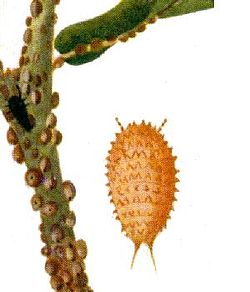| Eriococcus coriaceus | |
|---|---|
 | |
| Eriococcus coriaceus, the gumtree scale | |
| Scientific classification | |
| Kingdom: | Animalia |
| Phylum: | Arthropoda |
| Class: | Insecta |
| Order: | Hemiptera |
| Suborder: | Sternorrhyncha |
| Family: | Eriococcidae |
| Genus: | Eriococcus |
| Species: | E. coriaceus |
| Binomial name | |
| Eriococcus coriaceus Maskell, 1893 | |
Eriococcus coriaceus is a scale insect of the genus Eriococcus . [1] Its common names include blue gum scale, [2] gum-tree scale [3] and common gum scale. [1] It lives mostly on species from the Eucalyptus genus.[ citation needed ]